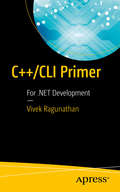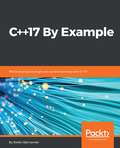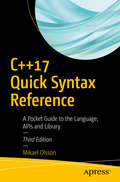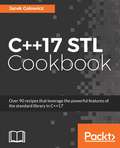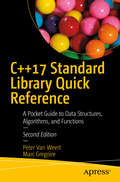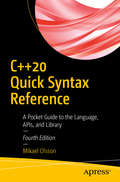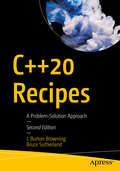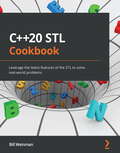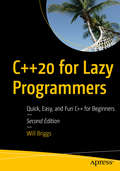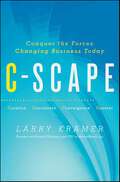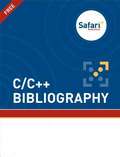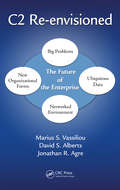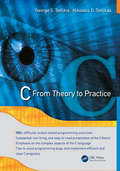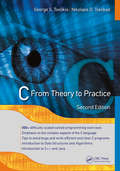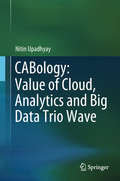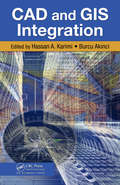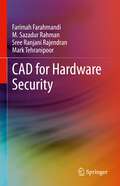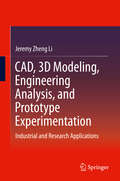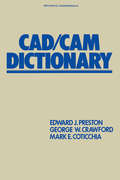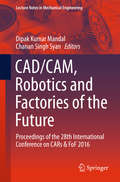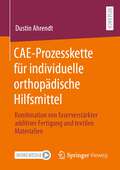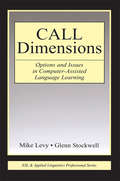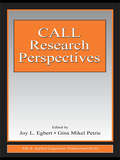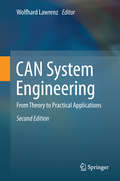- Table View
- List View
C++/CLI Primer: For .NET Development
by Vivek RagunathanEnter a world of hardcore back-end, server-side enterprise programming on the . NET platform. This book presents some of the important aspects of the C++/CLI language that often become a barrier preventing programmers from exploring further. The C++/CLI Primer is a powerful but compact book that will guide you through that barrier. Many of today's complex transactions and enterprise applications count on C++/CLI. Visual Studio 2015 and earlier versions support C++/CLI if you program using an IDE. C++/CLI is unattractive, clumsy, and hard when compared to other modern languages that run on the . NET platform. That's because it is powerful. Like light that can be viewed as a wave or particle, C++/CLI can be exercised as an unmanaged or managed or actually as the sandwich language to do mixed mode programming, which is its real power. That's also why it is unique. What You'll Learn Discover C++/CLI and why is it used in . NET programming Work with types, primitive types, object creation, and managed and abstract classes Use abstract classes in C++/CLI Harness the power of nullptre Implement code that uses boxing/unboxing Use equality/identity, properties, enums, strings, arrays, and more Who This Book Is For Experienced Microsoft . NET application developers, familiar with . NET framework and C++.
C++17 By Example: Practical projects to get you up and running with C++17
by Stefan BjörnanderDiscover the impressive capabilities of C++ and learn the skills you need to implement it in real life Key Features Leverage the power of C++ language constructs to build effective software Learn about file handling and pointers Build visually appealing GUI by using the power of Qt5 Get a deeper understanding of how to program C++ for a specific purpose by implementing a Domain Specific Language Book Description C++ is a general-purpose programming language built with a bias towards embedded programming and systems programming. Over the years, C++ has evolved and is used to develop software for many different sectors. Given its versatility and robustness, C++is a wonderful language to start your coding journey with. This book covers exciting projects built in C++ that show how to implement the language in different scenarios. While developing these projects, you will not only learn the language constructs but also how you can use C++ to meet your software requirements. The book starts with a brief introduction to C++ language constructs where you will learn essential concepts that are required to understand the projects covered in the book. The first module will build a library management system that will teach you how to perform efficient file handling and use pointers in your software. To give you a taste of GUI programming, the next module will build graphical applications using Qt 5. You will then be introduced to game design in C++ and build two interesting games. The final module will teach you how C++ can be used to create a Domain Specific Language. After reading this book, you will have mastered core programming concepts in C++, and how to implement them effectively. What you will learn Create object-oriented hierarchies and how to compile, link, and execute a simple program Implement classes with linked lists, templates, inheritance, operator overloading, and exception handling Efficient file handling and pointer structures Dynamic allocation and deallocation along with marshmallowing Qt features, including menus, toolbars, caret handling, and more Implement a Domain Specific Language in C++ Who this book is for This book is for developers who would like to develop software in C++. Basic programming experience would be an added advantage.
C++17 Quick Syntax Reference: A Pocket Guide To The Language, Apis And Library
by Mikael OlssonThis quick C++17 guide is a condensed code and syntax reference to the popular programming language, fully updated for C++17. It presents the essential C++ syntax in a well-organized format that can be used as a handy reference.In the C++17 Quick Syntax Reference, you will find short, simple, and focused code examples. This book includes a well laid out table of contents and a comprehensive index allowing for easy review. You won’t find any technical jargon, bloated samples, drawn out history lessons, or witty stories in this book. What you will find is a language reference that is concise, to the point and highly accessible. The book is packed with useful information and is a must-have for any C++ programmer.What You'll LearnUse template argument deduction for class templatesDeclare non-type template parameters with auto-folding expressions and auto deduction from braced-init-listApply lambdas and lambda capture by valueWork with inline variables, nested namespaces, structured bindings, and selection statements with initializerUse utf-8 character literalsCarry out direct-list initialization of enumsUse these new C++17 library features or class templates from std::variant, optional, any, string_view, invoke, apply and moreDo splicing for maps and sets, also new to C++17Who This Book Is ForExperienced C++ programmers. Additionally, this is a concise, easily-digested introduction for other programmers new to C++.
C++17 STL Cookbook
by Jacek GalowiczOver 90 recipes that leverage the powerful features of the Standard Library in C++17 About This Book • Learn the latest features of C++ and how to write better code by using the Standard Library (STL). Reduce the development time for your applications. • Understand the scope and power of STL features to deal with real-world problems. • Compose your own algorithms without forfeiting the simplicity and elegance of the STL way. Who This Book Is For This book is for intermediate-to-advanced C++ programmers who want to get the most out of the Standard Template Library of the newest version of C++: C++ 17. What You Will Learn • Learn about the new core language features and the problems they were intended to solve • Understand the inner workings and requirements of iterators by implementing them • Explore algorithms, functional programming style, and lambda expressions • Leverage the rich, portable, fast, and well-tested set of well-designed algorithms provided in the STL • Work with strings the STL way instead of handcrafting C-style code • Understand standard support classes for concurrency and synchronization, and how to put them to work • Use the filesystem library addition available with the C++17 STL In Detail C++ has come a long way and is in use in every area of the industry. Fast, efficient, and flexible, it is used to solve many problems. The upcoming version of C++ will see programmers change the way they code. If you want to grasp the practical usefulness of the C++17 STL in order to write smarter, fully portable code, then this book is for you. Beginning with new language features, this book will help you understand the language's mechanics and library features, and offers insight into how they work. Unlike other books, ours takes an implementation-specific, problem-solution approach that will help you quickly overcome hurdles. You will learn the core STL concepts, such as containers, algorithms, utility classes, lambda expressions, iterators, and more, while working on practical real-world recipes. These recipes will help you get the most from the STL and show you how to program in a better way. By the end of the book, you will be up to date with the latest C++17 features and save time and effort while solving tasks elegantly using the STL. Style and approach This recipe-based guide will show you how to make the best use of C++ together with the STL to squeeze more out of the standard language
C++17 Standard Library Quick Reference: A Pocket Guide to Data Structures, Algorithms, and Functions
by Marc Gregoire Peter Van WeertThis quick reference is a condensed guide to the essential data structures, algorithms, and functions provided by the C++17 Standard Library. It does not explain the C++ language or syntax, but is accessible to anyone with basic C++ knowledge or programming experience. Even the most experienced C++ programmer will learn a thing or two from it and find it a useful memory-aid. It is hard to remember all the possibilities, details, and intricacies of the vast and growing Standard Library. This handy reference guide is therefore indispensable to any C++ programmer. It offers a condensed, well-structured summary of all essential aspects of the C++ Standard Library. No page-long, repetitive examples or obscure, rarely used features. Instead, everything you need to know and watch out for in practice is outlined in a compact, to-the-point style, interspersed with practical tips and well-chosen, clarifying examples. This new edition is updated to include all Standard Library changes in C++17, including the new vocabulary types std::string_view, any, optional, and variant; parallel algorithms; the file system library; specialized mathematical functions; and more.What You Will LearnGain the essentials that the C++ Standard Library has to offerUse containers to efficiently store and retrieve your dataInspect and manipulate your data with algorithms See how lambda expressions allow for elegant use of algorithmsDiscover what the standard string class provides and how to use itWrite localized applicationsWork with file and stream-based I/OPrevent memory leaks with smart pointersWrite safe and efficient multi-threaded code using the threading librariesWho This Book Is ForAll C++ programmers, irrespective of their proficiency with the language or the Standard Library. A secondary audience is developers who are new to C++, but not new to programming, and who want to learn more about the C++ Standard Library in a quick, condensed manner.
C++20 Quick Syntax Reference: A Pocket Guide to the Language, APIs, and Library
by Mikael OlssonThis quick C++ 20 guide is a condensed code and syntax reference to the popular programming language, fully updated for C++20. It presents the essential C++20 code syntax in a well-organized format that can be used as a handy reference. This edition covers topics including designated initializers, lambdas and lambda captures, the spaceship operator, pack expressions, string literals as template parameters, atomic smart pointers, and contracts. It also covers library changes including extended futures, latches and barriers, task blocks, and text formatting. In the C++20 Quick Syntax Reference, you will find short, simple, and focused code examples. This book includes a well-laid-out table of contents and a comprehensive index allowing for easy review. You won’t find any technical jargon, bloated samples, drawn out history lessons, or witty stories in this book. What you will find is a language reference that is concise, to the point, and highly accessible. The book is packed with useful information and is a must-have for any C++ programmer. What You'll LearnDiscover the key C++20 featuresWork with concepts to constrain template argumentsUse modules as a replacement for header filesTake advantage of the three-way comparison operatorCreate immediate functions using the consteval keywordMake use of constexpr, constinit and designated initializers Who This Book Is For Experienced C++ programmers. Additionally, this is a concise, easily-digested introduction for other programmers new to C++.
C++20 Recipes: A Problem-Solution Approach
by Bruce Sutherland J. Burton BrowningDiscover the newest major features of C++20, including modules, concepts, spaceship operators, and smart pointers. This book is a handy code cookbook reference guide that covers the C++ core language standard as well as some of the code templates available in standard template library (STL). In C++20 Recipes: A Problem-Solution Approach, you'll find numbers, strings, dates, times, classes, exceptions, streams, flows, pointers, and more. Also, you'll see various code samples, templates for C++ algorithms, parallel processing, multithreading, and numerical processes. It also includes 3D graphics programming code. A wealth of STL templates on function objects, adapters, allocators, and extensions are also available. This is a must-have, contemporary reference for your technical library to help with just about any project that involves the C++ programming language. What You Will Learn See what's new in C++20 Write modules Work with text, numbers, and classes Use the containers and algorithms available in the standard library Work with templates, memory, concurrency, networking, scripting, and more Code for 3D graphics Who This Book Is For Programmers with at least some prior experience with C++.
C++20 STL Cookbook: Leverage the latest features of the STL to solve real-world problems
by Bill WeinmanProven techniques to improve the efficiency of your programs using the Standard Template Library (STL)Key FeaturesBecome familiar with the latest features of C++20 and write better code using the STLReduce the development time for your applications and enable faster deploymentGet up and running with the new and leaner STL capabilities introduced in the latest releaseBook DescriptionFast, efficient, and flexible, the C++ programming language has come a long way and is used in every area of the industry to solve many problems. The latest version C++20 will see programmers change the way they code as it brings a whole array of features enabling the quick deployment of applications. This book will get you up and running with using the STL in the best way possible.Beginning with new language features in C++20, this book will help you understand the language's mechanics and library features and offer insights into how they work. Unlike other books, the C++20 STL Cookbook takes an implementation-specific, problem-solution approach that will help you overcome hurdles quickly. You'll learn core STL concepts, such as containers, algorithms, utility classes, lambda expressions, iterators, and more, while working on real-world recipes. This book is a reference guide for using the C++ STL with its latest capabilities and exploring the cutting-edge features in functional programming and lambda expressions.By the end of the book C++20 book, you'll be able to leverage the latest C++ features and save time and effort while solving tasks elegantly using the STL.What you will learnUnderstand the new language features and the problems they can solveImplement generic features of the STL with practical examplesUnderstand standard support classes for concurrency and synchronizationPerform efficient memory management using the STLImplement seamless formatting using std::formatWork with strings the STL way instead of handcrafting C-style codeWho this book is forThis book is for intermediate to advanced C++ programmers who want to get the most out of the Standard Template Library of C++20, the newest version of C++. Basic knowledge of coding and C++ concepts is necessary to get started with this book.
C++20 for Lazy Programmers: Quick, Easy, and Fun C++ for Beginners
by Will BriggsReady to learn programming with less effort and more fun? Then do it the lazy way! C++20 for Lazy Programmers uses humor and fun to make you actually willing to read and eager to do the projects as you master the popular and powerful C++ language. Along the way it includes many features from the new C++20 standard, such as ranges, spans, format strings, the “spaceship” operator, and concepts (template parameter requirements), and provides brief introductions to modules and coroutines.With this unique method, you’ll stretch your abilities with a variety of projects, including your own C++ arcade game. You'll construct your own classes, templates, and abstract data types. After reading and using this book you’ll be ready to build real-world C++ applications and game projects on your own.What You Will Learn:The brand-new C++20 standardProgramming graphics and games with the SDL library, using SSDL, the "Simple SDL" wrapper libraryHow to use the most common C++ compilers -- Visual Studio for Windows, and g++ (with Unix or MinGW) -- and their associated debuggers“Anti-bugging” for easy fixes to common problems Sound practices for becoming a productive programmerHow to make your own big projects, including a C++-based arcade game The built-in Standard Template Library (STL) functions and classes for easy and efficient programmingPowerful data types including strings, stacks, vectors, and linked lists -- not by reading about them but by building them -- preparing you further for a career in programmingWho This Book Is ForAll who are new to C++, either self-learners or students in college-level courses.
C-Scape: Conquer the Forces Changing Business Today
by Larry Kramer“[Larry Kramer’s] MarketWatch.com is not just my favorite business website, it’s my personal homepage.” —Warren Buffett“[Larry Kramer] is the toughest and most ethical foe imaginable. His observations reflect a deep understanding of how the media works and what consumers want.” —Jim CramerFrom Larry Kramer, the founder of MarketWatch.com and former president of CBS Digital Media, comes a bold, pioneering report on what businesses must do to survive and thrive in the digital media revolution. Using case studies of companies such as Apple, Procter & Gamble, Netflix, and GE, Kramer not only draws a clear map of twenty-first century commerce, but charts the way forward. Readers wondering how to implement digital-age business strategies like those found in Clay Shirky’s Here Comes Everybody, Chris Anderson’s The Long Tail, or Jeff Jarvis’ What Would Google Do, look no further than Kramer’s groundbreaking C-Scape.
C/C++ Bibliography
by Safari Content TeamThe contents of this guide take you through the basics of C and C++ programming, from understanding the language form and layout through to using libraries and structures that enable you to build software. Some programming experience is expected in any other language.Developing application using C or C++ requires understanding the core elements of the language, such as the structure and format, alongside the ability to use both functional and object-oriented programming architectures to achieve your goals. C/C++ includes a wide variety of different libraries and environments, such as the Standard Template Library, and these extend the functionality and interface of the C/C++ programming environment to support a rich development environment. Following this bibliography will give you an excellent grounding in C and C++ programming using the books and content of Safari Books Online.
C2 Re-envisioned: The Future of the Enterprise
by Marius S. Vassiliou David S. Alberts Jonathan Russell AgreCommand and Control (C2) is the set of organizational and technical attributes and processes by which an enterprise marshals and employs human, physical, and information resources to solve problems and accomplish missions.C2 Re-envisioned: The Future of the Enterprise identifies four interrelated megatrends that are individually and collectively sh
C: From Theory to Practice
by George S. TselikisDesigned for a compulsory fundamental course, C: From Theory to Practice uses a hands-on approach to teach the C programming language, using numerous examples and a clear, concise presentation. Easy to use and classroom tested, this textbook includes more than 500 exercises and examples of progressive difficulty to help students in understanding al
C: From Theory to Practice, Second Edition
by George S. Tselikis Nikolaos D. TselikasThis easy-to-use, classroom-tested textbook covers the C programming language for computer science and IT students. Designed for a compulsory fundamental course, it presents the theory and principles of C. More than 500 exercises and examples of progressive difficulty aid students in understanding all the aspects and peculiarities of the C language. The exercises test students on various levels of programming and the examples enhance their concrete understanding of programming know-how. Instructor's manual and PowerPoint slides are available upon qualifying course adoption
CABology: Value Of Cloud, Analytics And Big Data Trio Wave
by Nitin UpadhyayThis uniquely accessible book helps readers use CABology to solve real-world business problems and drive real competitive advantage. It provides reliable, concise information on the real benefits, usage and operationalization aspects of utilizing the “Trio Wave” of cloud, analytic and big data. Anyone who thinks that the game changing technology is slow paced needs to think again. This book opens readers’ eyes to the fact that the dynamics of global technology and business are changing. Moreover, it argues that businesses must transform themselves in alignment with the Trio Wave if they want to survive and excel in the future. CABology focuses on the art and science of optimizing the business goals to deliver true value and benefits to the customer through cloud, analytic and big data. It offers business of all sizes a structured and comprehensive way of discovering the real benefits, usage and operationalization aspects of utilizing the Trio Wave.
CAD and GIS Integration
by Hassan A. Karimi Burcu AkinciWhen used together effectively, computer-aided design (CAD) and geospatial information systems (GIS) have a solid track record for streamlining decision making and reducing inefficiencies in the design, planning, and execution of critical operations and projects. And a growing number of engineering tasks in numerous fields-including design, archite
CAD for Hardware Security
by Mark Tehranipoor Farimah Farahmandi Sree Ranjani Rajendran M. Sazadur RahmanThis book provides an overview of current hardware security problems and highlights how these issues can be efficiently addressed using computer-aided design (CAD) tools. Authors are from CAD developers, IP developers, SOC designers as well as SoC verification experts. Readers will gain a comprehensive understanding of SoC security vulnerabilities and how to overcome them, through an efficient combination of proactive countermeasures and a wide variety of CAD solutions.
CAD, 3D Modeling, Engineering Analysis, and Prototype Experimentation: Industrial and Research Applications
by Jeremy Zheng LiThis succinct book focuses on computer aided design (CAD), 3-D modeling, and engineering analysis and the ways they can be applied effectively in research and industrial sectors including aerospace, defense, automotive, and consumer products. These efficient tools, deployed for R&D in the laboratory and the field, perform efficiently three-dimensional modeling of finished products, render complex geometrical product designs, facilitate structural analysis and optimal product design, produce graphic and engineering drawings, and generate production documentation. Written with an eye toward green energy installations and novel manufacturing facilities, this concise volume enables scientific researchers and engineering professionals to learn design techniques, control existing and complex issues, proficiently use CAD tools, visualize technical fundamentals, and gain analytic and technical skills. This book also: · Equips practitioners and researchers to handle powerful tools for engineering design and analysis using many detailed illustrations · Emphasizes important engineering design principles in introducing readers to a range of techniques · Includes tutorials providing readers with appropriate scaffolding to accelerate their learning process · Adopts a product development, cost-consideration perspective through the book's many examples
CAD/CAM Dictionary
by Edward J. PrestonThis book presents general computer definitions and abbreviations as well as application-specification terminology related to the world of CAD/CAM in alphabetical order.
CAD/CAM, Robotics and Factories of the Future: Proceedings of the 28th International Conference on CARs & FoF 2016 (Lecture Notes in Mechanical Engineering)
by Dipak Kumar Mandal Chanan Singh SyanThis volume is based on the proceedings of the 28th International Conference on CAD/CAM, Robotics and Factories of the Future. This book specially focuses on the positive changes made in the field of robotics, CAD/CAM and future outlook for emerging manufacturing units. Some of the important topics discussed in the conference are product development and sustainability, modeling and simulation, automation, robotics and handling systems, supply chain management and logistics, advanced manufacturing processes, human aspects in engineering activities, emerging scenarios in engineering education and training. The contents of this set of proceedings will prove useful to both researchers and practitioners.
CAE-Prozesskette für individuelle orthopädische Hilfsmittel: Kombination von faserverstärkter additiver Fertigung und textilen Materialien
by Dustin AhrendtDie im Rahmen der Dissertation erarbeitete CAE-gestützte Prozesskette vom kundenspezifischen 3D-Scan bis zum konfektionierten Produkt ermöglicht die Kombination von anwendungsgerecht additiv gefertigten Faserkunststoffelementen direkt auf flächigen Textilmaterialien. Dadurch lassen sich individuelle orthopädische Hilfsmittel fertigen, was anhand einer exemplarischen Entwicklung für das Kniegelenk aufgezeigt wird. Das neuartige orthopädische Hilfsmittel verbindet eine textile Kompressionsbandage mit biegesteifen Orthesenelementen. Die anforderungsgerechte Auslegung und Evaluation erfolgte simulationsgestützt.
CALL Dimensions: Options and Issues in Computer-Assisted Language Learning (ESL & Applied Linguistics Professional Series)
by Glenn Stockwell Mike LevyThis volume gives language teachers, software designers, and researchers who wish to use technology in second or foreign language education the information they need to absorb what has been achieved so far and to make sense of it. It is designed to enable the kind of critical reading of a substantial literature that leads to a balanced and detailed knowledge of the field. Chapter by chapter, the book builds, through description, analysis, examples, and discussion, a detailed picture of modern CALL. In this book, the label “CALL” is interpreted broadly to include technology-enhanced language learning, Web-enhanced language learning, and information and communication technologies for language learning. The work is distinguished by its attention to a range of languages rather than just English. The authors first set the scene and introduce major areas of interest and growth in CALL, and then look in depth at seven important dimensions: design, evaluation, computer-mediated communication, theory, research, practice, and technology. Chapters on each of these topics include a description that reviews the recent literature, identifies themes, and presents representative projects that illustrate the dimension, followed by a discussion that provides in-depth analysis, and a conclusion offering suggestions for further work. Detailed references and links connect the description and discussion with original works and primary sources so the reader can follow up easily on areas of personal interest. Two concluding chapters discuss how the various dimensions might be brought together, the first from a practical point of view, the second with a view to the development of CALL as a whole.
CALL Research Perspectives (ESL & Applied Linguistics Professional Series)
by Joy L. Egbert Gina Mikel PetrieCALL Research Perspectives creates a foundation for the study and practice of computer-assisted language learning and provides an overview of ways to conceptualize and to conduct research in CALL. Its core assumptions are that all approaches to research have a place, and that researchers, teachers, and students all have a role to play in the study of computer-enhanced language learning.This is not a how-to-do-research text. Written by top researchers in the field, it offers an open-ended view of what educators need to know and be able to do to answer questions that they have. It is intended to be easy to read, to provide resources for readers to explore the ideas further, and to be non-prescriptive in presenting suggestions for CALL research. The text explores problems with current CALL research and suggests ways that teachers and other researchers can avoid such problems; presents both commonly known and less explored theories that provide a foundation for CALL and language research; and addresses other issues and ideas that affect research outcomes.An outstanding feature of CALL Research Perspectives is that it complements not only other CALL texts but also research texts of all kinds. The issues found in each chapter parallel the issues in other research texts, making this text useful for addressing the needs of teachers and researchers at different levels and in different contexts. In addition, the consistent format throughout makes it accessible to readers with a variety of backgrounds. Each chapter includes an introduction, a review of relevant literature, a set of examples and/or suggestions for conducting research in CALL, and conclusions. The consistent format is intended for ease of use, but the content of chapters varies according to the author. This is intentional; it is a strength of the book that readers can hear the voices of the authors and listen to their understandings of the perspectives presented. It is the editors' hope that they will be inspired to seek out other voices as well.
CAN System Engineering: From Theory to Practical Applications
by Wolfhard LawrenzThis book addresses the various challenges and open questions relating to CAN communication networks. Opening with a short introduction into the fundamentals of CAN, the book then examines the problems and solutions for the physical layout of networks, including EMC issues and topology layout. Additionally, a discussion of quality issues with a particular focus on test techniques is presented. Each chapter features a collection of illuminating insights and detailed technical information supplied by a selection of internationally-regarded experts from industry and academia. Features: presents thorough coverage of architectures, implementations and application of CAN transceiver, data link layer and so-called higher layer software; explains CAN EMC characteristics and countermeasures, as well as how to design CAN networks; demonstrates how to practically apply and test CAN systems; includes examples of real networks from diverse applications in automotive engineering, avionics, and home heating technology.
